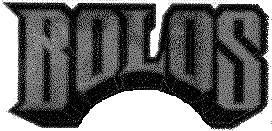BOLOS


During the long period of cold war following A.D. 1945, development continued, especially in the United States. By 1989 the direct ancestor of the Bolo line had been constructed by the Bolo Division of General Motors. This machine, at one hundred fifty tons almost twice the weight of its Phase Two predecessors, was designated the Bolo Mark I Model B. No Bolo Model A of any mark ever existed, since it was felt that the Ford Motor Company had pre-empted that designation permanently. The same is true of the name "Model T."
The Mark I was essentially a bigger and better conventional tank, carrying a crew of three and, via power-assisted servos, completely manually operated, with the exception of the capability to perform a number of preset routine functions such as patrol duty with no crew aboard. The Mark II that followed in 1995 was even more highly automated, carrying an on-board fire-control computer and requiring only a single operator. The Mark III of 2020 was considered by some to be almost a step backward, its highly complex controls normally requiring a crew of two, though in an emergency a single experienced man could fight the machine with limited effectiveness. These were by no means negligible weapons systems, their individual firepower exceeding that of a contemporary battalion of heavy infantry, while they were of course correspondingly heavily armored and shielded. The outer durachrome war hull of the Mark III was twenty millimeters thick and capable of withstanding any offensive weapon then known, short of a contact nuclear blast.
The first completely automated Bolo, designed to operate normally without a man aboard, was the landmark Mark XV Model M, originally dubbed Resartus for obscure reasons, but later officially named Stupendous. This model, first commissioned in the twenty-fifth century, was widely used throughout the Eastern Arm during the Era of Expansion and remained in service on remote worlds for over two centuries, acquiring many improvements in detail along the way while remaining basically unchanged, though increasing sophistication of circuitry and weapons vastly upgraded its effectiveness. The Bolo Horrendous Model R, of 2807 was the culmination of this phase of Bolo development, though older models lingered on in the active service of minor powers for centuries.
Thereafter the development of the Mark XVI thru XIX consisted largely in further refinement and improvement in detail of the Mark XV. Provision continued to be made for a human occupant, now as a passenger rather than an operator, usually an officer. who wished to observe the action at first hand. Of course, these machines normally went into action under the guidance of individually prepared computer programs, while military regulations continued to require installation of devices for halting or even self-destructing the machine at any time. This latter feature was mainly intended to prevent capture and hostile use of the great machine by an enemy. It was at this time that the first-line Bolos in Terran service were organized into a brigade, known as the Dinochrome Brigade, and deployed as a strategic unit. Tactically the regiment was the basic Bolo unit.
The always-present though perhaps unlikely possibility of capture and use of a Bolo by an enemy was a constant source of anxiety to military leaders and, in time, gave rise to the next and final major advance in Bolo technology: the self-directing (and, quite incidentally, self-aware) Mark XX Model B Bolo Tremendous. At this time it was customary to designate each individual unit by a three-letter group indicating hull style, power unit, and main armament. This gave rise to the custom of forming a nickname from the letters, such as "Johnny" from JNY, adding to the tendency to anthropomorphize the great fighting machines.
The new XX was at first greeted with little enthusiasm by the High Command, who now professed to believe that an unguided-by-operator Bolo would potentially be capable of running amok and wreaking destruction on its owners. Many observers have speculated by hindsight that a more candid objection would have been that the legitimate area of command function was about to be invaded by mere machinery. Machinery the Bolos were, but never mere.
At one time an effort was made to convert a number of surplus Bolos to peacetime use by such modifications as the addition of a soil-moving blade to a Mark XII Bolo Continental Siege Unit, the installation of seats for four men, and the description of the resulting irresistible force as a "tractor." This idea came to naught, however, since the machines retained their half--megaton/second fire power and were never widely accepted as normal agricultural equipment.
As the great conflict of the post-thirtieth-century era wore on... a period variously known as the Last War and, later, as the Lost war... Bolos of Mark XXVIII and later series were organized. into independently operating brigades that did their own strategic as well as tactical planning. Many of these machines still exist in functional condition in out-of the-way corners of the former Terran Empire. At this time the program of locating and neutralizing these ancient weapons continues.
|
|
All images and excerpts on these pages are copyright by Baen Books and/or Bill Fawcett and Associates. No infringement of their rights or ownership is intended. |